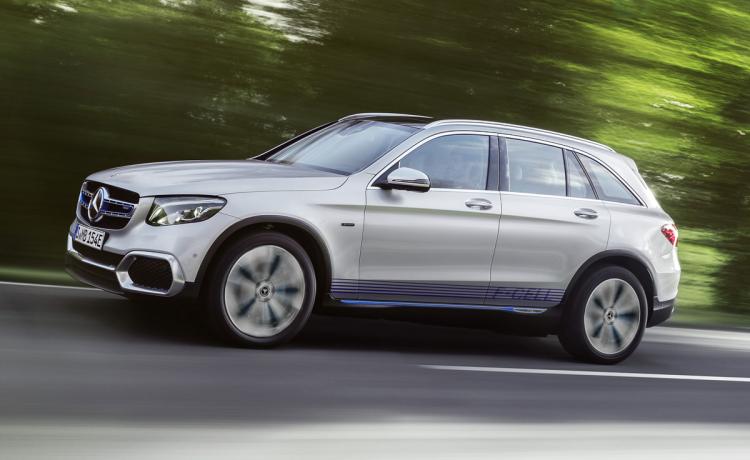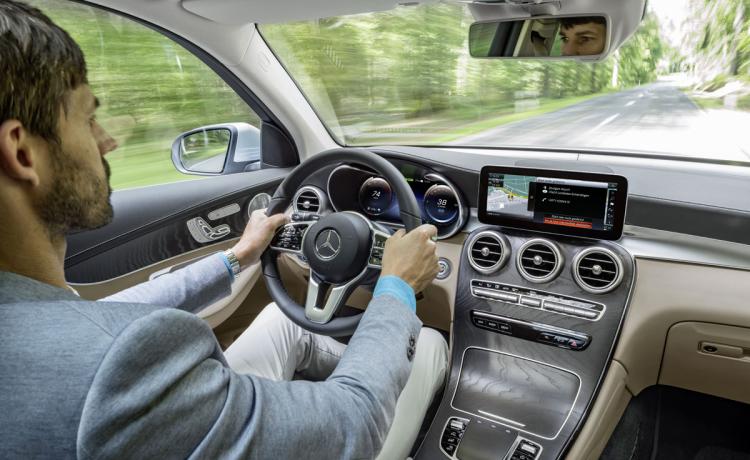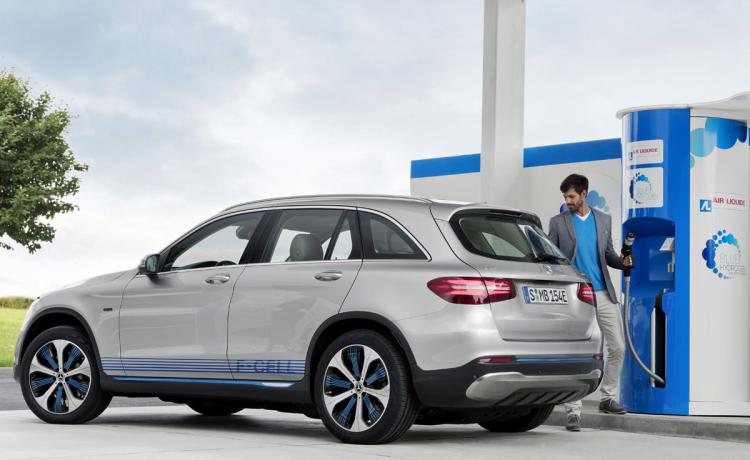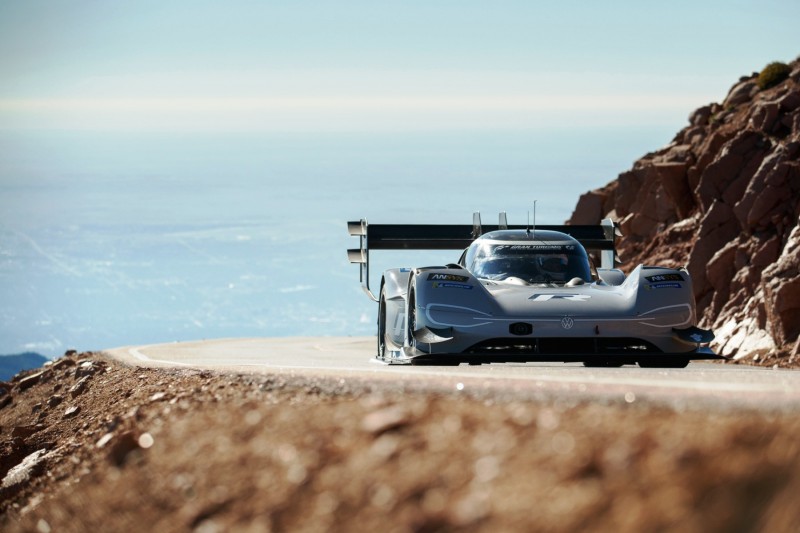Two things about the 2020 Mercedes-Benz GLC F-Cell are potential game changers within the hydrogen-powered vehicle landscape.
First, this pre-production SUV is actually good looking, which means that Honda and Toyota don’t have much of an excuse for the styling of the Clarity and Mirai.
Second, the GLC F-Cell runs on hydrogen fuel or on battery-stored electricity. Toyota’s Mirai requires access to hydrogen filling stations, while Honda’s Clarity lineup forces the consumer to choose between gas-electric plug-in hybrid, battery electric, and hydrogen electric drivetrains. The flexibility Mercedes brings to the field is key to encouraging adoption of fuel-cell technology while the necessary infrastructure is built.

Historically, fuel-cell vehicles were unattractive. The 2020 Mercedes-Benz GLC F-Cell proves false any maxim dictating ugly hydrogen car design.
(Mercedes-Benz)
I’m a huge fan of hydrogen-powered, fuel-cell vehicles. The fueling process is a familiar one, and takes far less time than charging a battery pack. Nothing but water vapor is emitted from the vehicle’s tailpipe. And hydrogen producers are increasingly using clean, green, sustainable methods to produce the fuel.
All that’s missing from a fuel-cell future is infrastructure. Well, that, and an attractively styled hydrogen vehicle.
With the 2020 GLC F-Cell, Mercedes solves for one of those challenges.

Smaller components allow Mercedes to tuck the GLC F-Cell’s drivetrain beneath the hood, the vehicle floor, and the rear seat.
(Mercedes-Benz)
Taking what it learned with the B-Class F-Cell, which the company offered in limited numbers starting in 2010, Mercedes-Benz has made several key improvements to its hydrogen fuel-cell technology.
Featuring a 147 kW electric motor making 197 horsepower and 258 lb.-ft. of torque, the GLC F-Cell is 40 percent more powerful than the B-Class F-Cell, and the drivetrain’s size is 30 percent smaller, allowing Mercedes to tuck all powertrain components under the SUV’s hood. Also, the fuel cell itself uses 90 percent less platinum in its construction, significantly reducing the costs associated with production.
Hydrogen is stored in two tanks, encased in carbon fiber and located both within the GLC F-Cell’s floor and underneath its back seat. Combined, they hold 4.4 kilograms of hydrogen, and new, globally standardized tank technology facilitates refueling in just three minutes, which is about how long a traditional gasoline tank requires.

Charging ports in the GLC F-Cell’s rear bumper allow the owner to charge the lithium-ion battery in as little as 90 minutes.
(Mercedes-Benz)
A 13.8 kWh lithium-ion battery is located beneath the SUV’s cargo area. It can be recharged in as little as 90 minutes when using a municipal fast-charger station. Plan for longer connection times with a 240-volt home charging station, and much longer times if you’re using a standard electrical outlet in your home.
Drivers select from four operation modes and three driving modes. The driving modes are both familiar and self-descriptive: Eco, Comfort, and Sport. The operating modes require explanation.
In F-Cell operating mode, the hydrogen in the fuel tanks powers the SUV. In Battery mode, the lithium-ion battery is the sole source of power, providing about 30 miles of range by European standards.
To maximize range, estimated to be about 270 miles on the European cycle, the Hybrid mode allows the GLC F-Cell to draw on both the battery and the hydrogen fuel, intelligently using each for optimal efficiency.
Finally, a Charge mode prioritizes charging of the battery, and also activates reserves of power for enthusiastic or uphill driving situations.

The GLC F-Cell offers nearly as much interior space as a standard GLC. Note the unique instrumentation and new touch-sensing version of the Comand infotainment system.
(Mercedes-Benz)
Mercedes-Benz assures potential GLC F-Cell buyers that it has put the vehicle through stringent safety testing that exceeds the requirements mandated by law. Furthermore, a full suite of driver assistance and collision avoidance systems is standard for this model.
Interior space is a little smaller than a standard GLC-Class. The cargo floor sits a little higher, as does the rear seat. An automatic climate control system can pre-condition the cabin for driving, as well as activate the heated seats and side mirrors.
Revised instrumentation reflects the drivetrain’s information delivery requirements. Mercedes also used the GLC F-Cell’s introduction at the 2017 International Auto Show in Frankfurt to introduce a new generation of its Comand infotainment system with a Multitouch handwriting recognition system and Linguatronic voice recognition technology.

Consumer demand for fuel-cell vehicles could outstrip fueling infrastructure. In the event that happens, the GLC F-Cell can travel short distances solely on its battery.
(Mercedes-Benz)
Mercedes-Benz isn’t new to fuel-cell vehicle design and engineering. The company’s first foray into fuel cells was the Necar 1 in 1994.
Today, the company plans to introduce 10 electric vehicles by 2022, and the company considers the GLC F-Cell to be “an important landmark,” characterizing it as “a family-friendly electric vehicle of high everyday practicality.”
By the time it goes on sale in the U.S. near the end of 2019, California is projected to have doubled its hydrogen fueling infrastructure to around 90 filling stations, and a handful of stations should be up and running in the Northeast.
Nevertheless, experts predict that consumer demand for fuel cells after 2020 is likely to outstrip fueling capability, posing potential problems for owners of hydrogen-powered vehicles.
Hedging its bet, Mercedes has engineered the GLC F-Cell to run for short distances purely on its battery. Though the solution isn’t ideal, it certainly serves to bridge the infrastructure gap between where we are today and where we’re going to be tomorrow.






